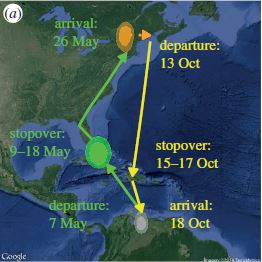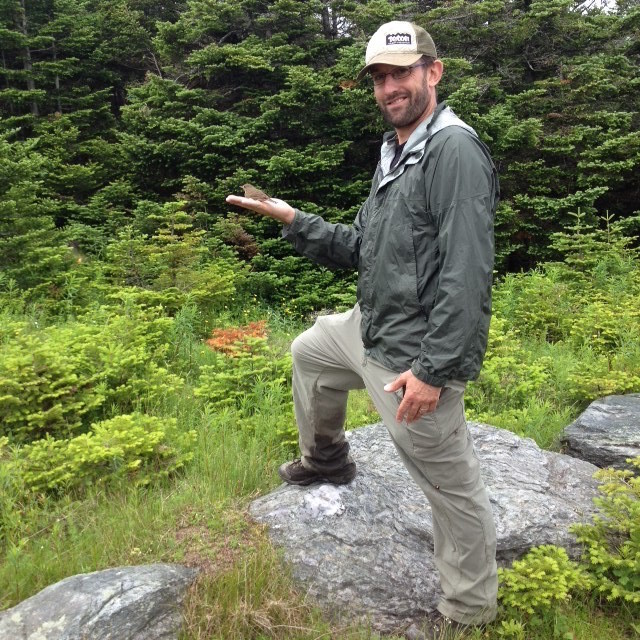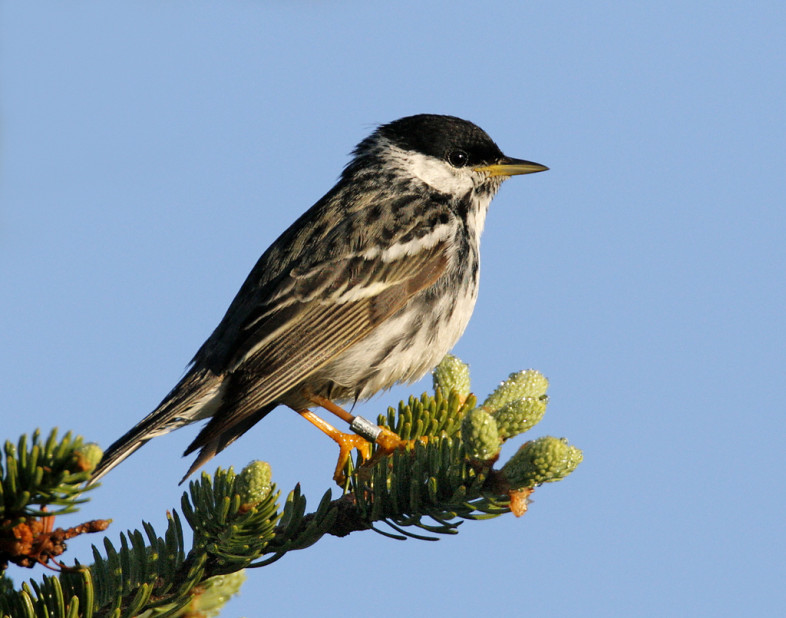No one with even a passing interest in birds can help being astounded by the spectacular migratory feat of Blackpoll Warblers. The species’ non-stop transAtlantic fall flight to its South American wintering grounds was recently confirmed in a published paper by VCE and our colleagues, via the use of light-level geolocators attached to male Blackpolls on Mt. Mansfield and in Nova Scotia. This diminutive half-ounce songbird routinely undertakes one of the most amazing migratory journeys on the planet. And, we now know, they do it successfully, year after year.
Earlier this week, on the morning of 7 July, UMass colleague Bill DeLuca (our paper’s senior author) and I were running mist nets on Mt. Mansfield, capturing the usual assortment of breeding thrushes, warblers and sparrows. At 6:20 am, Bill processed and released male Blackpoll #2540-59026, our 9th recapture of a previously banded bird so far this season (we’ve banded 15 new Blackpolls). The bird had flown into a net on the Amherst Trail, showed a trace amount of body fat, measured 74.0 mm on the wing, and weighed in at 11.4 grams. We were busy and didn’t look up its history until closing shop and coming down from the mountain.

The migratory trek of Blackpoll Warbler #2540-59026, fitted with a geolocator on Mt. Mansfield on 6 June 2013, recovered on 8 July 2014, and recaptured yet again on 7 July 2015. Yellow arrows indicate southward fall flight, green arrows the bird’s return spring trek to Mt. Mansfield.
A glance at our records proved this male to be one of the three that yielded its historic and precious geolocator data last summer. The story began on 8 June 2013, when we banded 2540-59026 as a yearling and fitted it with a geolocator, capturing it twice more that summer, always on the Amherst Trail. History was made on 8 July last year, when the bird again met the mesh of our mist net, in almost the exact same spot on the Amherst Trail. Downloading and subsequent analysis of its archived geolocator data revealed that 2540-59026 had completed a truly phenomenal overwater southward migration, the longest recorded among the five Blackpolls (our colleagues in Nova Scotia also recovered two males) from which we recovered geolocators. Its “flight log” indicated that the bird left Mansfield and headed east to the Maine or New Brunswick coast, then struck out over the Atlantic on 13 October, making landfall on Hispaniola a mere two-plus days later, resting and refueling on the island an additional two days, then arriving in either northern Colombia or Venezuela on the 18th. Its non-stop flight covered an estimated 2750 km, or 1709 miles, in a scant 64 hours!
As we tip our hats to champion globe-trotter 2540-59026, we realize much remains to be learned about Blackpoll Warblers. The species is declining across its extensive North American breeding range at a worrisome annual rate of almost 7%, and virtually nothing is known about its ecology or conservation status in winter. Nor do we know whether breeding populations further to the north and west of Vermont and Nova Scotia follow a similar fall migration pattern. Like so many other long-distance Nearctic-Neotropical migrants, the Blackpoll demands a full life-cycle approach to understanding and conserving its populations. With our partners like Bill Deluca, VCE hopes to be part of that approach for years to come.

Bill DeLuca, the Blackpoll Whisperer, with a banded Bicknell’s Thrush on Mt. Mansfield, 7 July 2015.

